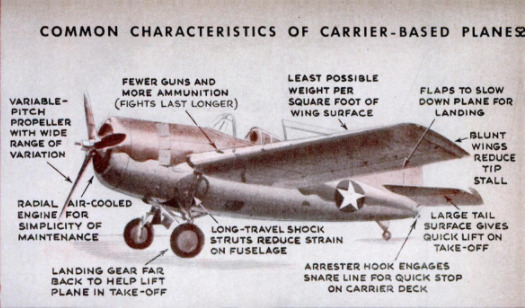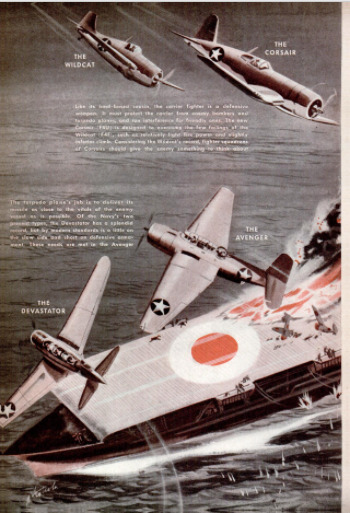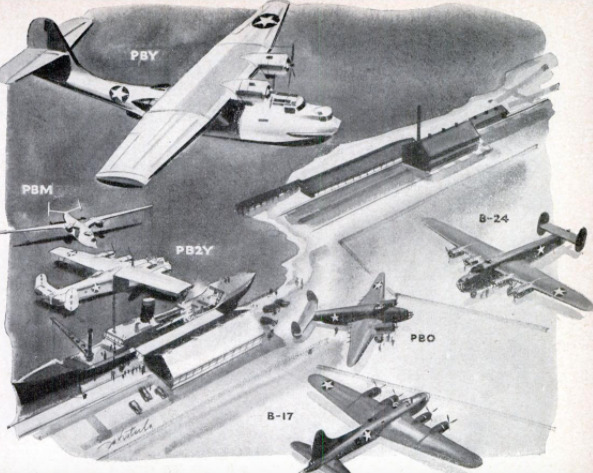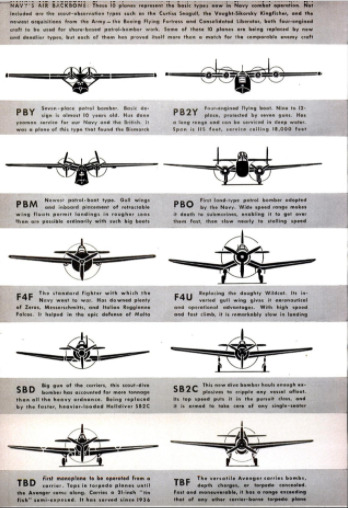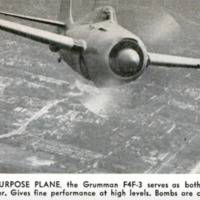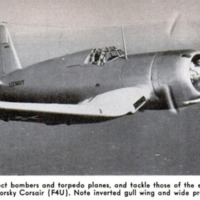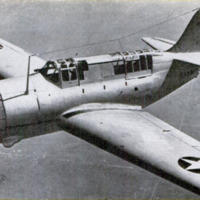-
Title (Dublin Core)
-
Combat Planes that support U.S. Navy
-
Article Title and/or Image Caption (Dublin Core)
-
Title: Our Navy strikes from the Sky
-
Subtitle: Here are the combat planes that support our sea power
-
extracted text (Extract Text)
-
AS THE war wears into its third year, no
doubt remains that the air arm holds
the margin between victory and defeat. At
sea, as the reports of naval action roll in, it
becomes increasingly apparent that the
great naval vessels that once were the back-
bone of naval strategy have been trans-
formed by the shifting pattern of events into
bases and auxiliaries for aircraft.
The reason is simple. A carrier with its
nest of planes can throw destruction farther
and faster than the best ship of the line. For
pure deadliness, for accuracy and economy
of fire, the dive bomber outstrips the big
naval gun by a fearful margin. The torpedo-
carrying airplane, backed by speed and
maneuverability which no surface or sub-
surface vessel can claim, scores fewer misses
per run-in than even the swift mosquito
boats. In modern naval action, the airplane
is in turn scouting force, ordnance, defense,
and light transport all rolled into one.
The importance to which the air phase of
naval warfare has mounted in recent months
is best exemplified by a side-light story that
has leaked out of the Coral Sea engagement.
A complete battle unit, sent out to overhaul
and cancel a major Jap carrier, had com-
pleted its task. A straggling scout bomber
arrived at the flat-top only to find her in
flames and listing. No use wasting the
valuable missile on her. The pilot scouted
for an alternative target and spotted an
enemy light cruiser. When the bomb hit,
the ship almost tore in half. The pilot then
proceeded back to his carrier, bombed up
and refueled and went out again on another
trip. It was not until much later that the
sinking of the cruiser came to light. When
the check-up was made as to how each bomb
was disposed of, the pilot admitted a little
apologetically that he had expended the
bomb on a mere light cruiser. Since it was
a non-airstrength vessel, he deemed it of so
little importance that reporting it classed
with landing an undersized fish that should
have been thrown back. Anything less than
a carrier is rated fairly small game.
Running an air navy is a complicated
business. Unlike land operations, new and
altering conditions have dictated unexpected
changes in design requirements for its air-
craft and general approach of operations.
Naval aircraft are divided into three classes.
Before the war, there were only two. First
there are shipboard airplanes, the carrier-
based fighters, scout-bombers and torpedo-
planes; cruisers carry catapult observation
craft. In the next class are harbor-based
long-range seaplanes; patrol craft and bomb-
ers, and far-ranging torpedo carriers by
turn. The newest category is that of land-
based scout-bombers. This is an innovation
gotten from the critiques of the battle of the
Coral Sea and from direct experience in
anti-submarine patrol.
Early carriers were converted freighters,
colliers, and similar makeshifts. Japan's
first flat-tops were heavy cruisers with
temporary landing decks, created in evasion
of the terms of the Washington Conference
which limited naval construction. The plan
was, when the time for war came, to alter
the supérstructure, mount heavy guns, and
send the ship to sea as a cruiser. It is an
odd reflection on the turn of the war to dis-
cover that many of the current Jap carriers
were originally laid down as cruisers and
other craft and hastily converted to swell
the carrier tonnage.
Our carriers are stocked with three basic
classes of aircraft: fighters, scout-bombers,
and torpedo planes. Their functions are
simple. The fighter protects
the carrier from enemy attack
or accompanies the scout-
bomber or torpedo plane to
its point of attack, fending
off the enemy interception.
The scout-bomber does some
of the scouting, but its chief
job is that taken over from
the big guns; diving down
and accurately planting ex-
plosives directly onto enemy
objectives — ships, land in-
stallations, etc. The torpedo
plane bears the deadliest marine missile
of all, the “tin fish” which it can haul
prodigious distances at high speed and carry
closer to the objective than any destroyer
or PT boat. As a destructive weapon, it
can take over one of the destroyer’s nastiest
jobs, completing it for a great deal less in-
vestment in equipment and risking a smaller
crew. The torpedo unit-casualty score be-
tween the four usual torpedo media—the
submarine, destroyer, mosquito boat, and
plane—gives the plane a fairly wide margin
when operating against armed surface
craft. Several things are in the plane's
favor. First there are fewer men (three)
involved in a torpedo-plane attempt. The
plane is the smallest target, moving at a far
greater speed. Both the destroyer and the
torpedo boat have one dimension of fire
fixed: they must be on the surface. The
submarine and the airplane alone may op-
erate at a multitude of levels and angles, in
a three-dimensional battleground. The sub
is definitely limited as to the depth at which
it can move in its medium and has a speed
inferior to most of its targets.
Most cruisers and carriers also carry a
few light, low-powered, far-ranging scout
observation planes such ag the Curtiss Sea-
gull and the Vought-Sikorsky Kingfisher,
either on wheels for straight deckboard op-
eration or on a single float, to be catapulted
off for fire correction for a cruiser’s guns.
The type's low power and light armament
make them so vulnerable that many naval
authorities discount them, and often their
duties are transferred to ships better cap-
able of combat.
Carrier planes are, at present, in the
process of transition. Changes in naval
types have necessarily been slower than in
those operated from land bases. To begin
with, types are changed in response to
known needs, actually shown in battle. Be-
cause Japan was the first enemy to come out
with any appreciable carrier strength, major
replacements had to be made only after the
facts were known. For the most part, our
types had adequate performance to hold
the enemy. The changes are made so that
we can not only keep ahead of him, but
boost performance by a large enough margin
so that we can positively and finally wrest
control of the air over the sea lanes. The
remainder will then be a fairly simple mili-
tary operation.
Our Navy went into the war with three
basic deckboard types. One was the Grum-
man F4F, affectionately known as the Wild-
cat. It was a nasty, stubby little airplane
with a 38-foot wing span. It weighed a bit
over 5,700 pounds, its top speed was above
340 miles per hour. It was armed with four
.50 caliber machine guns and hauled enough
gas to take it 1,100 miles.
It is a mistake to compare such per-
formance with that of the Hurricane, Spit-
tire, Warhawk, and other fast land-based
fighters. Shipboard-aircraft design is limited
by certain factors which do not affect the
land-based fighter. The entire landing area
for the shipboard fighter is the carrier deck
—300 yards long at the most. The fighter
must be off in a fraction of that. The fight-
er’s dimensions are limited by the elevator
facilities on existing carriers. Its range
must be almost as great as that of the dive
bombers and torpedo planes it is destined
to escort.
The shipboard fighter must have superior
maneuverability. In land fighting, it is pos-
sible for the attacking plane to make a
single pass at the enemy, but the carrier
ship must stay and fight. In the first place,
there are only a limited number of fighters
available. If the
fighter lets the enemy get by, he is likely to
have no carrier left to land on.
The gun-ammunition ratio in a naval
fighter is different from that of a land plane.
The average Army job calls for a major
weight investment in gun power for a with-
ering blast at the enemy, enough to make
the ship disintegrate. However, the ammuni-
tion allows only a short duration of fire. This
is based on the patrol system upon which
land fighting is predicated—the availability
of large numbers of airplanes so that if an
enemy force resists or evades one blast,
other ships can be sent to intercept it. The
carrier goes to sea with a definite number
of planes and replacements; additions or
reinforcements are simply unavailable. In
the carrier fighter, fewer guns are mounted,
most of the fighting weight being invested
in ammunition. In a concentrated naval ac-
tion, a Wildcat is likely to be attacked sev-
eral times. Therefore, being able to sustain
fire is vital. This puts great stress on the
quality of marksmanship.
There is a widespread belief that deck-
board fighters land much more slowly than
land-based pursuits. Actually, this is not
true. Having more room to land in, the
land-based Army fighter pilot can bring his
ship in on power, flying it parallel with the
field and settling slowly, losing the last of
his flying speed close to the ground. The
Navy fighter, on the other hand, has a frac-
tion of a moving quarter-acre deck to sit
down on. Each landing must be “full stall,”
that is, the ship must be brought in slowly
and, by the time the wheels touch the deck,
the wings must be devoid of lift. This re-
quires great lateral control at slow speeds.
This need, combined with the demand for as
much wing area for the span as is possible,
produces the stubby, square-tipped wing that
has made the Wildcat one of the most popu-
lar types ever
stocked for deckboard use. Even the British
admit that the F4F-—or Martlet, as they
call it in the Fleet Air Arm—is among
the hottest craft that ever dropped an
arrester hook on His Majesty's carriers.
The Wildcat, excellent as it is, must be
replaced. Carrier action in amphibious war-
fare often dictates that the deck-board fight-
er meet land-based fighters or intercept
high-altitude bombers. The next ship in line
seems to be the Vought-Sikorsky F4U-1, the
Corsair. A little bigger than the Wildcat, it
weighs almost twice as much, carries more
guns, and sustains a longer rate of fire. Its
2,000-hp. engine provides it a phenomenal
climb and a service ceiling closely approxi-
mating that of the best-known land-based
fighter craft. Most figures on the Corsair
are under restriction, but is safe to say that
total replacement of the older type will be
possible soon. There are several other nasty
surprises scheduled for the enemy. One of
them has acquired the affectionate nick-
name of “the big beast,” and the early re-
ports on its performance indicate that it is
turning out to be a terror.
Scout Bombers are the big guns of the
modern air fleet. Fast, quick-in-quick-out
ships, their job is to power-dive in at as
steep an angle as they dare. The diving
sight is the same instrument that is used to
direct the ship's forward fixed guns. The
technique of dive bombing has altered con-
siderably since the Navy first demonstrated
it over ten years ago. Originally, the pilot
merely glued his sight on the target and
dived the ship dead on,
pulling out at as close
an altitude as he consid-
ered safe. The first dive
bombers were wire-and-
strut biplanes, and their
parasite resistance kept
the airplane from gath-
ering an uncontrollable
amount of speed.
Since that time, anti-
aircraft tactics have been
improved, so that a pilot
attempting the old-fash-
ioned straight bombing
dive would be a dead
duck and even the high
speed of his ship would
be little protection. The
modern dive bomber is
an exceptionally clean
airplane, and uncon-
trolled diving would per-
mit the accumulation of
more speed than is neces-
sary or useful. To control
this excess speed in a
dive, air brakes are em-
ployed. The popular U. S. design is a double
perforated flap at the trailing edge of the
wing which sweeps both up and down, in-
creasing the resistance and decelerating the
airplane. The old-fashioned direct dive has
been changed to circuitous approach pat-
terns which are highly varied and often
completely unpredictable. As the bombs
that the dive bomber carries increase in size,
it becomes necessary to release them at a
higher altitude to prevent their explosion
from wrecking the plane as well as the
target.
The currently used craft is the Douglas
“Dauntless,” which hauls a single 500-pound
bomb 1,000 miles at a speed exceeding 250
miles per hour. The Dauntless has an un-
equaled record in the Pacific. It was in this
type that the immortal Lieutenant Powers
“laid one on the deck” of a Jap battlewagon,
carrying it to less than 500 feet and going
down with his victim.
Oddly enough, the Dauntless is being re-
placed, not because it could not do its job,
but because it was so successful that it
proved for all time that dive bombers could
be trusted with practically every job ever
given to a full naval gun. The only thing it
lacked was the heavy-weight missile. The
Curtiss Helldiver, the SB2C, built to haul
four times the Dauntless’s bomb weight for
1,200 miles at a greater speed, is now swing-
ing into full production. This type is capable
of sinking almost any vessel afloat all by
itself. Armed more heavily than its pred-
ecessor, it can, if necessary, fly to an ob-
jective with a minimum
of fighter support. In the
Dauntless, the bombs
stowed externally, caus-
ing considerable parasite
resistance in the air. The
speed difference, checked
agains actual tests, indi-
cated a 15-m.p.h. differ-
ence without the bombs.
As a check, 500 pounds
of dead weight were
stowed inside for the
comparative run. In the
Helldiver, the bombs are
stowed internally.
Unless you count the
helpless cargo craft sunk
by submarines, the tor-
pedo plane is tops in the
sinking of war tonnage.
So far, the only sure cure
for the torpedo plane is
the fighter. Until recent-
ly our fleet has been
equipped with the TBD,
the old Douglas Devas-
tator, the first monoplane ever to be op-
erated from a carrier. Developed from the
Douglas XT3D-1, it went into service in
1936 and has served, unmodified and un-
changed, until its duties were taken over by
the newer Grumman TBF or Avenger.
Of all carrier jobs, this is admittedly the
toughest kind of flying. Even on deck, be-
fore take-off, its 50-foot wing is folded back,
and the pilot has to taxi into line by forward
signals from the yellow-shirted trafic man.
He must unfold his wings as he goes, mini-
mizing the time loss between ship take-offs.
Having to haul the greatest load the great-
est distance, the TB usually is the lightest
armed of the three general classes. The
fighter has its maneuverability and its arma-
ment to Keep it safe, the dive bomber has
enough guns to keep it out of trouble and
can, if necessary, outdive the attacker. The
torpedo bomber, however, is a sitting duck
in the average set of approaches and re-
quires, for the most part, fighter escort.
The Devastator served a longer useful
career than any single fighting design in the
Air navy’s history. While she will probably
still be seen around for many months to
come, the Coral Sea action indicated the
need for a ship that would not require quite
such close attendance on the part of the
fighters. The Navy needed a more versatile
major air vehicle for the carriers. The re-
sult was the TBF, the Grumman Avenger.
The Avenger bears a strong family resem-
blance to the Wildcat, and a lot of the claw-
ing F4F’s characteristics remain. The
Avenger carries the 21-inch Bliss-Leavitt
‘torpedo internally rather than semiexposed
as in the Devastator.
‘The Avenger’s total armament is close to
that of a fighter, although not concentrated
in one place for maximum effectiveness. It
is not designed to look for combat. However,
with guns forward, in the turret, and
through the belly, it is a nasty customer to
tackle. Unlike the TBD, the Grumman can
be used to lay depth charges or carry a
load of bombs well above 20,000 feet.
‘This is the current stock for the carriers.
As for shore-based planes, the Navy is op-
erating several types of long-range land
planes. Prominent among these is the PBAY,
the Consolidated B-24 four-engined bomber
known as the Liberator. The Lockheed
Ventura, designed to take up where the
famed Hudson left off, was borrowed from
the English to become the PBO. The B-17,
the Boeing Flying Fortress, will appear
shortly in Navy stripes. In actual warfare,
many basic weaknesses were discovered in
the operation of large flying boats. The main
shortcoming was the fact that no flying boat
could be equipped with a gun emplacement
in the bottom. More than a third of the
hull surface is totally blind area.
The remainder of the PB series is invested
in the traditional flying boats, currently the
PBY or twin-engined Catalina boat; the
PB2Y, its big brother, the four-engined
Coronado; and the PBM, the Martin Mariner.
This type has been designed primarily for
long-range overseas scouting, accommodat-
ing crews of between seven and 15 men.
They are capable of remaining in the air
over long periods regardless of the vagaries
of the weather. When used as bombers, they
must be capable of getting out of the water
with large loads of bombs, depth charges, or
torpedoes and must carry enough defensive
armament to compensate for their relative
slowness.
‘The flying boat has many operational ad-
vantages. Any sheltered strip of water is a
base for a seaplane. In ordinary weather, a
seaplane tender, a small, inexpensive ship,
can service it and keep it going even at sea.
Furthermore, the development of remote-
control firing positions now under investiga-
tion may reduce the blind-spot objection. |
Now that the pattern of sea-air warfare
has been established, modifications in naval-
plane design must be made accordingly. Al-
though it has been a close fight, one major:
portion of the victory is already ours. This
is the battle of design philosophy.
Japan planned for a quick victory at sea.
She planned to pay for it by sacrificing pilot
and air-crew safety for a small percentage
of climbing and turning ability. Japan's
engine development lagged behind ours. The
largest power plant she has exhibited this
far is about 1250 horsepower. To achieve
performance with these smaller engines, she,
had to pare down size and weight. The re-
sult was the Misubishi Zero and her series
of dive and torpedo bombers, Light and un-
armored, these ships disintegrated under
fire. The newer series of Jap fighters indi-
cate a trend toward armor and self-sealing;
tanks. Not that Japan has acquired any,
more respect for human life, but that the
pllot losses have been greater than she could
afford for the amount of air control she thus
far has gained. This means that Japan must
scrap a lot of her research, alter production,
and plug the gap with makeshifts, Chang-
ing her mind is going to cost her the war,
-
Contributor (Dublin Core)
-
William S. Friedman (Article Writer)
-
Language (Dublin Core)
-
eng
-
Date Issued (Dublin Core)
-
1943-02
-
pages (Bibliographic Ontology)
-
68-77,233,235
-
Rights (Dublin Core)
-
Public Domain (Google Digitized)
-
Archived by (Dublin Core)
-
Matteo Ridolfi
-
Marco Bortolami (editor)
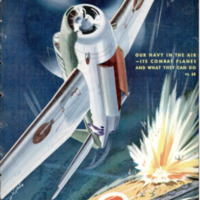 Popular Science Monthly, v. 142, n. 2, 1943
Popular Science Monthly, v. 142, n. 2, 1943

